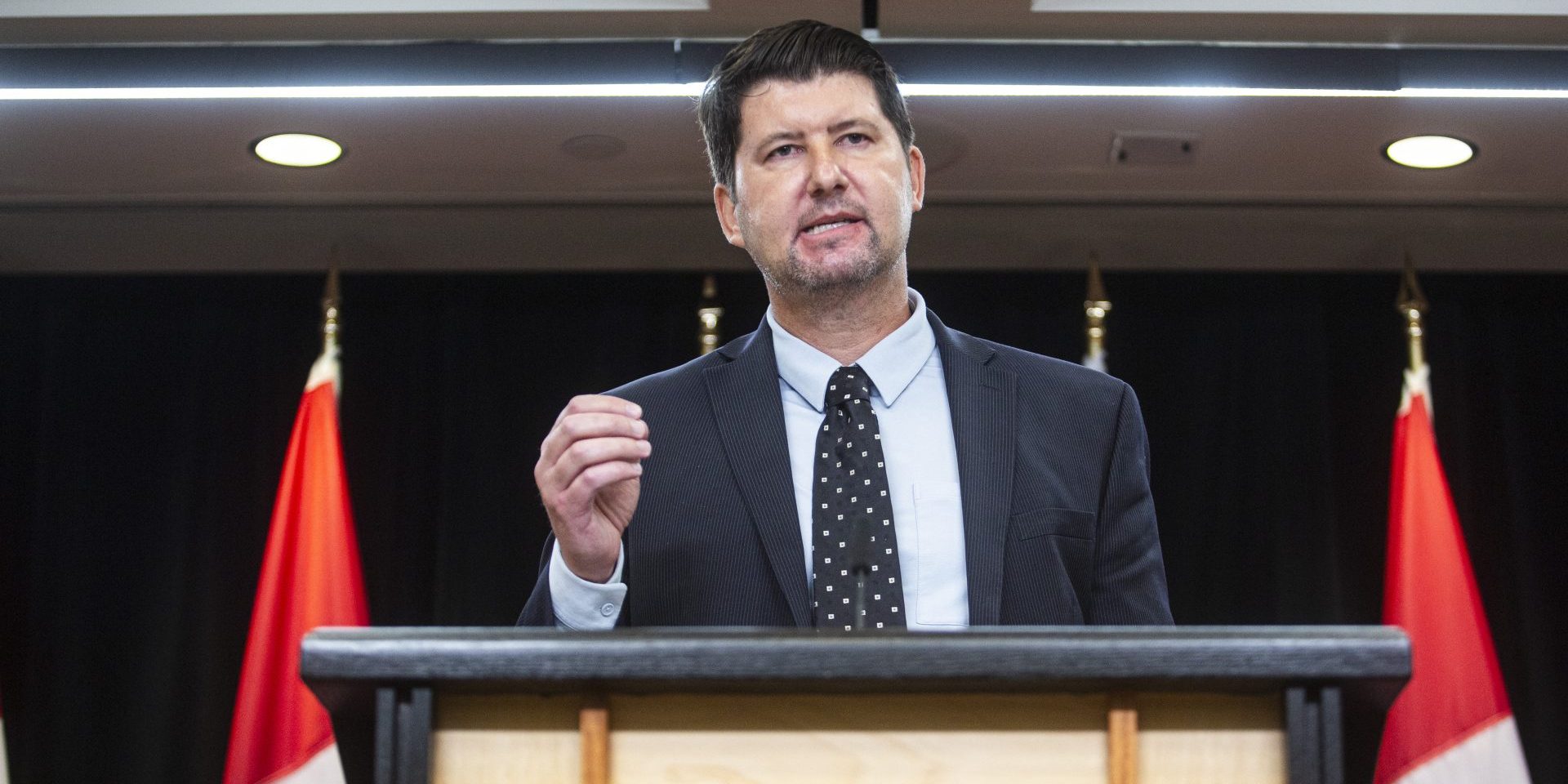‘We can no longer sustain Band-Aid solutions’: watchdog calls for urgent changes to federal procurement

Canada’s problem-ridden procurement system is “in need of fundamental change,” with the most urgent fix being the creation of a chief procurement officer to address decades-long dysfunction, says a federal watchdog.
“There’s seemingly an acknowledgement that the system is not working effectively. If we do not act now, I fear that I could be before you in two years’ time, at the end of my mandate, saying the same things—and to be honest, I can’t,” Procurement Ombud Alexander Jeglic told reporters on July 8.
“The truth is the system needs to be overhauled.”
Jeglic was speaking following the release of a report from his office identifying five foundational changes he said are required to improve federal procurement, and fill the void in clear accountability and leadership. A chief procurement officer (CPO) would be seminal to implementing the other four measures, he said.
“We can no longer sustain Band-Aid solutions. We have to address the foundational issue that our system is too complex, and it’s not working for all participants,” Jeglic told reporters. If established, a “CPO will be charged with the responsibility of ushering us through that change.”
Recommendations also include the creation of a government-wide vendor performance management (VPM) system, the development of a universally applicable set of federal procurement rules, the increased use of artificial intelligence in procurement processes, and the establishment of a government-wide framework for data collection. The report also flags Indigenous procurement, defence procurement, and innovation and partnerships as areas in need of reform.
In the report, Jeglic noted that the current procurement system is “marked by silos of responsibility and accountability that sometimes overlap with each other or leave glaring gaps.”
“When accountabilities and responsibilities in a procurement system are not exceptionally clear, it becomes very difficult to address the problems plaguing the system,” the report said.
The ombud’s recommendations drew on interviews with a dozen federal procurement experts from industry, academia, and law, as well as survey responses from procurement officers from federal departments and internal input from its own specialists. It also reviewed regulatory and policy frameworks and strategies in procurement both within Canada and internationally.
Creating chief procurement officer role is ‘critical’, says Jeglic
A CPO would be new for the federal government, though similar positions exist in some provinces and in other countries like the United Kingdom.

Jeglic said a CPO could streamline the overly complex procurement process, and find the balance between the policy-creator and policy-implementor divide created by the shared procurement responsibilities between the Treasury Board and Public Services and Procurement Canada (PSPC).
A CPO could also tackle issues around capacity building and professionalization for federal procurement practitioners, and address the lack of a federal VPM system that would hold poor-performing suppliers to account, the report suggested.
According to the report, almost 60 per cent of procurement specialists consulted ranked the creation of a CPO as a high priority, with many expressing concern over the need for training and professionalization across the system, as well as worry about high employee turnover, inconsistent job classifications, and unclear expectations.
The ombud suggested the new office could be created under either the Treasury Board Secretariat or PSPC. While creating the position would require changes to the machinery of government, Jeglic underlined that Ottawa should find a way to do it without adding more layers of bureaucracy.
Lack of a proper performance management system lets ‘bad performers’ win contracts: report
Creating a VPM system to inform the selection process for future contracts would help weed out underperforming suppliers, suspend or prevent them from bidding on future contracts, or reward high-performing vendors, according to the report.
Not having such a system in place would prevent the federal government from awarding new contracts to known “bad performers,” Jeglic said.
The ombud noted that when each department does its own vendor performance management framework, there is no way for departments to easily share the data they have on individual vendors, allowing “known poor performers” to seek contracts in different departments.
The ombud’s office previously conducted three studies on vendor performance management—in 2010, 2014, and 2019—all of which came to the conclusion that “a robust VPM system will increase fairness in the process,” and it would ensure standards are met and value for money is achieved.
The ombud highlighted that the VPM system is already used in provinces like Ontario, Quebec, Alberta, Saskatchewan, as well as within some municipalities.
The report also notes that PSPC launched an internal pilot project for VPM in August 2023. While the Office of the Procurement Ombud called this “a promising step,” it is still in the early stages.
The report recommends “developing one universally applicable set of procurement rules” to reduce the overly complex nature of the federal procurement environment for both suppliers and procurement specialists.
“The adoption of a strong, consistent, single set of rules in the form of statute or regulation would untangle the complex layers and help streamline federal procurement.”
Jeglic’s report also noted that some procurement specialists believed they were already operating under a single ruleset under the Directive on the Management of Procurement, but consultations revealed inconsistent application of those rules across departments.
Two technological recommendations by the ombud include the use of AI advancements to modernize federal procurement tools, systems and processes, and the establishment of a framework for procurement data collection to increase information sharing across federal organizations and promote transparency.
The report notes, based on its consultations, that AI could increase efficiency by reducing the time and effort involved in the overall procurement process, and eliminating redundant tasks. However, the ombud notes that the employment of AI “must be supported by a fulsome procurement data strategy that would feed into such a system,” and cautions the federal government to “take time to leverage AI effectively and carefully.”

The new Government Transformation, and Public Works and Procurement Minister Joël Lightbound (Louis-Hébert, Que.) had previously told The Hill Times that he sees “many opportunities” in using AI to streamline federal procurement, enhance oversight of process, contracts and vendors, and lighten the workload of public servants.
The ombud’s final recommendation is to establish a government-wide framework for procurement data collection to increase transparency in federal procurements. Jeglic noted that data collection in federal procurement is a challenge because “there is no federal government-wide centralized, standardized, and automated procurement system to capture and share data.”
The report highlighted that accurate data is crucial for making informed decisions, noting that procurement issues often arise from inaccurate or incomplete data.
Auditor General Karen Hogan’s 2024 report on the procurement of the ArriveCan application was the first to highlight major weaknesses in contracting, documentation, and oversight indicating a lack of transparency and accountability in the procurement process.
PSPC manages approximately $37-billion annually on behalf of federal departments and agencies. Over the last couple of years, the department has faced criticism due to a series of contracting controversies, political scrutiny, committee showdowns, scathing watchdog reports, the historic admonishment of a contractor, and multiple RCMP investigations.
Canada’s federal procurement system has long been criticized for its heavy reliance on outside consultants and contractors. In 2023-24, Ottawa spent a record $20.7-billion on outsourcing, and reports show that IT contractors cost at least 22-per-cent more than in‑house staff. Critics have repeatedly said that outsourcing professional services leads to higher costs in government projects, reduced transparency, and a loss of institutional knowledge within the public service.
Jeglic released multiple reports over the last two years addressing costly errors and delays in federal procurement and conducted investigations into controversial contracts ArriveCan and McKinsey. He has expressed frustration with the slow progress of the previous Liberal government in fixing them.
ikoca@hilltimes.com
The Hill Times






 LICENSING
LICENSING PODCAST
PODCAST ALERTS
ALERTS













